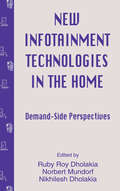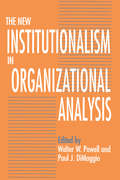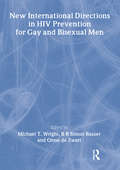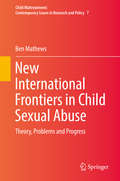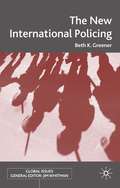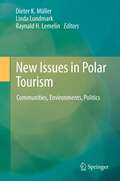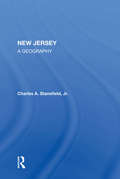- Table View
- List View
The New Individualism: The Emotional Costs of Globalization REVISED EDITION
by Anthony Elliott Prof Charles LemertThis is a new and revised edition of a book which has had a major impact upon the social sciences and public political debate. Anthony Elliott and Charles Lemert's THE NEW INDIVIDUALISM inspired readers with the dramatic suggestion that 'the reinvention craze' - from self-help and therapy culture to management restructurings and corporate downsizings - is central to a 'new individualism' sweeping the globe. Giving particular attention to the narratives of people seeking to define anew their lives in an age of globalization, the authors contend that an endless hunger for instant change and relentless emphasis on self-reinvention is fundamental to grasping the disorientating effects of the new individualism. This edition contains a substantial new Introduction in which Elliott and Lemert reply to some of the standard criticisms made of the theory of the new individualism, and also addresses the escalation of new individualist thinking in the wake of recent global crises.
The New Individualism: The Emotional Costs of Globalization REVISED EDITION
by Anthony Elliott Prof Charles LemertThis is a new and revised edition of a book which has had a major impact upon the social sciences and public political debate. Anthony Elliott and Charles Lemert's THE NEW INDIVIDUALISM inspired readers with the dramatic suggestion that 'the reinvention craze' - from self-help and therapy culture to management restructurings and corporate downsizings - is central to a 'new individualism' sweeping the globe. Giving particular attention to the narratives of people seeking to define anew their lives in an age of globalization, the authors contend that an endless hunger for instant change and relentless emphasis on self-reinvention is fundamental to grasping the disorientating effects of the new individualism. This edition contains a substantial new Introduction in which Elliott and Lemert reply to some of the standard criticisms made of the theory of the new individualism, and also addresses the escalation of new individualist thinking in the wake of recent global crises.
A New Industrial Future?: 3D Printing and the Reconfiguring of Production, Distribution, and Consumption (Antinomies)
by John Urry Thomas BirtchnellA New Industrial Future? examines whether a further industrial revolution is taking place around the world. In this compelling book Birtchnell and Urry examine such a new possible future involving the mass adoption of 3D printing. The locating of 3D printers in homes, offices, stores and workshops would disrupt existing systems and pose novel challenges for incumbents. The book drawing upon expert interviews, scenario workshops and various case studies assesses the potential future of global manufacturing, freight transport, world trade and land use. It offers the first book-length social scientific analysis of the character and impacts of a new system of manufacturing that is in formation. The book will be of interest to urban planners, policy makers, social scientists, futurologists, economists, as well as general readers by offering inquiry on this future upheaval in the means of production.
A New Industrial Future?: 3D Printing and the Reconfiguring of Production, Distribution, and Consumption (Antinomies)
by John Urry Thomas BirtchnellA New Industrial Future? examines whether a further industrial revolution is taking place around the world. In this compelling book Birtchnell and Urry examine such a new possible future involving the mass adoption of 3D printing. The locating of 3D printers in homes, offices, stores and workshops would disrupt existing systems and pose novel challenges for incumbents. The book drawing upon expert interviews, scenario workshops and various case studies assesses the potential future of global manufacturing, freight transport, world trade and land use. It offers the first book-length social scientific analysis of the character and impacts of a new system of manufacturing that is in formation. The book will be of interest to urban planners, policy makers, social scientists, futurologists, economists, as well as general readers by offering inquiry on this future upheaval in the means of production.
New infotainment Technologies in the Home: Demand-side Perspectives (Routledge Communication Series)
by Ruby Roy Dholakia Norbert Mundorf Nikhilesh DholakiaAs the "information superhighway" moves into the home through interactive media, enhanced telecom services, and hybrid appliances, interest continually grows in how consumers adopt and use Information Technology (IT), the strategies IT marketers use to reach consumers, and the public policies that help and protect consumers. USE COPY FROM THIS POINT ON FOR GENERAL CATALOGS... This book presents a unique collection of papers dealing with the demand side issues of new information technologies in the home. The contributors are from business, academia, and the public policy sector and represent many disciplines including communication, marketing, economics, psychology, engineering, and information systems. This book provides one of the best introductions to complex issues such as: * business forces that will shape "Home IT" of the future; * industry structure of the future "Infotainment" mega-business; * factors affecting consumer adoption and use of IT; * international differences in the management of the IT sector; and * public policies that will shape the deployment and use of IT.
New infotainment Technologies in the Home: Demand-side Perspectives (Routledge Communication Series)
by Ruby Roy Dholakia Norbert Mundorf Nikhilesh DholakiaAs the "information superhighway" moves into the home through interactive media, enhanced telecom services, and hybrid appliances, interest continually grows in how consumers adopt and use Information Technology (IT), the strategies IT marketers use to reach consumers, and the public policies that help and protect consumers. USE COPY FROM THIS POINT ON FOR GENERAL CATALOGS... This book presents a unique collection of papers dealing with the demand side issues of new information technologies in the home. The contributors are from business, academia, and the public policy sector and represent many disciplines including communication, marketing, economics, psychology, engineering, and information systems. This book provides one of the best introductions to complex issues such as: * business forces that will shape "Home IT" of the future; * industry structure of the future "Infotainment" mega-business; * factors affecting consumer adoption and use of IT; * international differences in the management of the IT sector; and * public policies that will shape the deployment and use of IT.
The New Institutionalism in Organizational Analysis
by Edited by Walter W. Powell and Paul J. DiMaggioLong a fruitful area of scrutiny for students of organizations, the study of institutions is undergoing a renaissance in contemporary social science. This volume offers, for the first time, both often-cited foundation works and the latest writings of scholars associated with the "institutional" approach to organization analysis. In their introduction, the editors discuss points of convergence and disagreement with institutionally oriented research in economics and political science, and locate the "institutional" approach in relation to major developments in contemporary sociological theory. Several chapters consolidate the theoretical advances of the past decade, identify and clarify the paradigm's key ambiguities, and push the theoretical agenda in novel ways by developing sophisticated arguments about the linkage between institutional patterns and forms of social structure. The empirical studies that follow—involving such diverse topics as mental health clinics, art museums, large corporations, civil-service systems, and national polities—illustrate the explanatory power of institutional theory in the analysis of organizational change. Required reading for anyone interested in the sociology of organizations, the volume should appeal to scholars concerned with culture, political institutions, and social change.
The New Institutionalism in Organizational Analysis
by Edited by Walter W. Powell and Paul J. DiMaggioLong a fruitful area of scrutiny for students of organizations, the study of institutions is undergoing a renaissance in contemporary social science. This volume offers, for the first time, both often-cited foundation works and the latest writings of scholars associated with the "institutional" approach to organization analysis. In their introduction, the editors discuss points of convergence and disagreement with institutionally oriented research in economics and political science, and locate the "institutional" approach in relation to major developments in contemporary sociological theory. Several chapters consolidate the theoretical advances of the past decade, identify and clarify the paradigm's key ambiguities, and push the theoretical agenda in novel ways by developing sophisticated arguments about the linkage between institutional patterns and forms of social structure. The empirical studies that follow—involving such diverse topics as mental health clinics, art museums, large corporations, civil-service systems, and national polities—illustrate the explanatory power of institutional theory in the analysis of organizational change. Required reading for anyone interested in the sociology of organizations, the volume should appeal to scholars concerned with culture, political institutions, and social change.
The New Institutionalism in Organizational Analysis
by Walter W. Powell Paul J. DiMaggioLong a fruitful area of scrutiny for students of organizations, the study of institutions is undergoing a renaissance in contemporary social science. This volume offers, for the first time, both often-cited foundation works and the latest writings of scholars associated with the "institutional" approach to organization analysis. In their introduction, the editors discuss points of convergence and disagreement with institutionally oriented research in economics and political science, and locate the "institutional" approach in relation to major developments in contemporary sociological theory. Several chapters consolidate the theoretical advances of the past decade, identify and clarify the paradigm's key ambiguities, and push the theoretical agenda in novel ways by developing sophisticated arguments about the linkage between institutional patterns and forms of social structure. The empirical studies that follow—involving such diverse topics as mental health clinics, art museums, large corporations, civil-service systems, and national polities—illustrate the explanatory power of institutional theory in the analysis of organizational change. Required reading for anyone interested in the sociology of organizations, the volume should appeal to scholars concerned with culture, political institutions, and social change.
The New Institutionalism in Organizational Analysis
Long a fruitful area of scrutiny for students of organizations, the study of institutions is undergoing a renaissance in contemporary social science. This volume offers, for the first time, both often-cited foundation works and the latest writings of scholars associated with the "institutional" approach to organization analysis. In their introduction, the editors discuss points of convergence and disagreement with institutionally oriented research in economics and political science, and locate the "institutional" approach in relation to major developments in contemporary sociological theory. Several chapters consolidate the theoretical advances of the past decade, identify and clarify the paradigm's key ambiguities, and push the theoretical agenda in novel ways by developing sophisticated arguments about the linkage between institutional patterns and forms of social structure. The empirical studies that follow—involving such diverse topics as mental health clinics, art museums, large corporations, civil-service systems, and national polities—illustrate the explanatory power of institutional theory in the analysis of organizational change. Required reading for anyone interested in the sociology of organizations, the volume should appeal to scholars concerned with culture, political institutions, and social change.
New Institutions for Participatory Democracy in Latin America: Voice and Consequence
by Kenneth E. SharpeThis volume describes and analyzes the proliferation of new mechanisms for participation in Latin American democracies and considers the relationship between direct participation and the consolidation of representative institutions based on more traditional electoral conceptions of democracy.
New Interdisciplinary Perspectives On and Beyond Autonomy (Warwick Series in the Humanities)
by Christopher Watkin Oliver DavisWhat does ‘autonomy’ mean today? Is the Enlightenment understanding of autonomy still relevant for contemporary challenges? How have the limits and possibilities of autonomy been transformed by recent developments in artificial intelligence and big data, political pressures, intersecting oppressions and the climate emergency? The challenges to autonomy today reach across society with unprecedented complexity, and in this book leading scholars from philosophy, economics, linguistics, literature and politics examine the role of autonomy in key areas of contemporary life, forcefully defending a range of different views about the nature and extent of resistance to autonomy today. These essays are essential reading for anyone who wants to understand the predicament and prospects of one of modernity’s foundational concepts and one of our most widely cherished values. Chapter 5.6 and 9 of this book is freely available as a downloadable Open Access PDF at http://www.taylorfrancis.com under a Creative Commons [Attribution-Non Commercial-No Derivatives (CC-BY-NC-ND)] 4.0 license.
New Interdisciplinary Perspectives On and Beyond Autonomy (Warwick Series in the Humanities)
by Christopher Watkin Oliver DavisWhat does ‘autonomy’ mean today? Is the Enlightenment understanding of autonomy still relevant for contemporary challenges? How have the limits and possibilities of autonomy been transformed by recent developments in artificial intelligence and big data, political pressures, intersecting oppressions and the climate emergency? The challenges to autonomy today reach across society with unprecedented complexity, and in this book leading scholars from philosophy, economics, linguistics, literature and politics examine the role of autonomy in key areas of contemporary life, forcefully defending a range of different views about the nature and extent of resistance to autonomy today. These essays are essential reading for anyone who wants to understand the predicament and prospects of one of modernity’s foundational concepts and one of our most widely cherished values. Chapter 5.6 and 9 of this book is freely available as a downloadable Open Access PDF at http://www.taylorfrancis.com under a Creative Commons [Attribution-Non Commercial-No Derivatives (CC-BY-NC-ND)] 4.0 license.
New International Directions in HIV Prevention for Gay and Bisexual Men
by Michael Wright B R RosserIt is widely recognized that current HIV intervention models are falling short of their goals. What are the alternatives?To answer this question, New International Directions in HIV Prevention for Gay and Bisexual Men presents a collection of articles from European and American authors that rival dominant paradigms of HIV prevention. Researchers, practitioners, and community organizations will be challenged to examine current assumptions and to consider neglected aspects of risk behavior such as love, trust, and the dynamics of sexual intimacy. New International Directions in HIV Prevention for Gay and Bisexual Men explores models and theories that will help you develop more effective HIV prevention programs to better serve patients and clients.New International Directions in HIV Prevention for Gay and Bisexual Men offers you fresh perspectives on prevention work by examining risk behaviors in the interactional, communal, and social contexts in which they are practiced. You will receive alternative explanations and reasons for HIV risk that go beyond current approaches and that introduce possibilities for new intervention strategies. Written by experts in the field, the chapters in New International Directions in HIV Prevention for Gay and Bisexual Men will give you insight into new ideas and developments, including: placing a greater emphasis on improving successful risk management strategies as opposed to quantifying risk factors examining the meaning and context of sexual acts which occur in casual encounters or steady partnerships and incorporating their relevancy into prevention work considering the effects that cultural context and socially constructed meanings have on prevention work and incorporating individuals’values and feelings into prevention strategies focusing on more realistic goals of harm reduction that take sexual decision making into consideration as opposed to expecting abstinence relating the various aspects of sexual encounters--physical attraction, intimacy, reciprocity, and power--to reasons why men choose not to use condomsExamining how gay men can underestimate the risk of HIV in order to meet needs of intimacy, New International Directions in HIV Prevention for Gay and Bisexual Men will help you understand the symbolic dimension of sexual contact. The normal, everyday reasons for having sex without a condom are explored, questioning models which often characterize unprotected sex as being the result of low self-esteem, substance abuse, or some other psychological vulnerability. Presenting data from both qualitative and quantitative research conducted at group and individual levels, this book reveals the complexity of risk behavior, the richness of sexual experience, and the importance of respecting the unique context in which gay men live their sexual lives. New International Directions in HIV Prevention for Gay and Bisexual Men will help you understand this point of view, enabling you to provide patients and clients with more effective HIV prevention and risk management services.
New International Directions in HIV Prevention for Gay and Bisexual Men
by Michael Wright B R RosserIt is widely recognized that current HIV intervention models are falling short of their goals. What are the alternatives?To answer this question, New International Directions in HIV Prevention for Gay and Bisexual Men presents a collection of articles from European and American authors that rival dominant paradigms of HIV prevention. Researchers, practitioners, and community organizations will be challenged to examine current assumptions and to consider neglected aspects of risk behavior such as love, trust, and the dynamics of sexual intimacy. New International Directions in HIV Prevention for Gay and Bisexual Men explores models and theories that will help you develop more effective HIV prevention programs to better serve patients and clients.New International Directions in HIV Prevention for Gay and Bisexual Men offers you fresh perspectives on prevention work by examining risk behaviors in the interactional, communal, and social contexts in which they are practiced. You will receive alternative explanations and reasons for HIV risk that go beyond current approaches and that introduce possibilities for new intervention strategies. Written by experts in the field, the chapters in New International Directions in HIV Prevention for Gay and Bisexual Men will give you insight into new ideas and developments, including: placing a greater emphasis on improving successful risk management strategies as opposed to quantifying risk factors examining the meaning and context of sexual acts which occur in casual encounters or steady partnerships and incorporating their relevancy into prevention work considering the effects that cultural context and socially constructed meanings have on prevention work and incorporating individuals’values and feelings into prevention strategies focusing on more realistic goals of harm reduction that take sexual decision making into consideration as opposed to expecting abstinence relating the various aspects of sexual encounters--physical attraction, intimacy, reciprocity, and power--to reasons why men choose not to use condomsExamining how gay men can underestimate the risk of HIV in order to meet needs of intimacy, New International Directions in HIV Prevention for Gay and Bisexual Men will help you understand the symbolic dimension of sexual contact. The normal, everyday reasons for having sex without a condom are explored, questioning models which often characterize unprotected sex as being the result of low self-esteem, substance abuse, or some other psychological vulnerability. Presenting data from both qualitative and quantitative research conducted at group and individual levels, this book reveals the complexity of risk behavior, the richness of sexual experience, and the importance of respecting the unique context in which gay men live their sexual lives. New International Directions in HIV Prevention for Gay and Bisexual Men will help you understand this point of view, enabling you to provide patients and clients with more effective HIV prevention and risk management services.
New International Frontiers in Child Sexual Abuse: Theory, Problems and Progress (Child Maltreatment #7)
by Ben MathewsThis book offers a timely and detailed exploration and analysis of key contemporary issues and challenges in child sexual abuse, which holds great relevance for scholarly, legal, policy, professional and clinical audiences worldwide. The book draws together the best current evidence about the nature, aetiology, contexts, and sequelae of child sexual abuse. It explores the optimal definition of child sexual abuse, considers sexual abuse in history, and explores new theoretical understandings of children’s rights and other key theories including public health and the Capabilities Approach, and their relevance to child sexual abuse prevention and responses. It examines a selection of the most pressing legal, theoretical, policy and practical challenges in child sexual abuse in the modern world, in developed and developing economies, including institutional child sexual abuse, female genital cutting, child marriage, the use of technology for sexual abuse, and the ethical responsibility and legal liability of major state and religious organisations, and individuals. It examines recent landmark legal and policy developments in all of these areas, drawing in particular on extensive developments from Australia in the wake of its Royal Commission Into Institutional Responses to Child Sexual Abuse. It also considers the best evidence about promising strategies and future promising directions in enhancing effective prevention, intervention and responses to child sexual abuse.
The New International Policing (Global Issues)
by B. GreenerPolice personnel have increasingly been deployed outside their own domestic jurisdictions to uphold law and order and to help rebuild states. This book explores the phenomenon of a 'new international policing' and outlines the range of challenges and opportunities it presents to both practitioners and theorists.
The New International Relations of Sub-Regionalism: Asia and Europe (Routledge Studies on Asia in the World)
by Hidetoshi Taga Seiichi IgarashiIn the context of the end of the Cold War and the spread of globalism, sub-regions are attracting attention as new social units of international society never before observed. In the "second wave" of regionalism that became active in the 1980s, a new regionalism, which differed qualitatively from the old regionalism, expanded globally. This "new regionalism" is characterized by multi-dimensionality, complexity, fluidity, and non-conformity, and within it we cannot overlook the fact that spaces on a new scale, such as sub-regions, are being formed in various parts of the world. The sovereign state system that has continued unbroken since the Westphalia Treaty is being transformed, and within this context, the increase in the number of sub-regions as new social units adds to the sense that we have arrived at a post-Westphalian international order. This book focuses on sub-region as a new social unit of international society. It is based on the findings obtained through meticulous fieldwork and joint studies conducted over the past 10 years by about 20 researchers, primarily from Japanese universities and Chiang Mai University, Thailand. The sub-regions described here are mostly international cross-border spaces or units in the interior of a certain region, which include: multiple states, states and parts of states, or more than two parts of states (often referred to as micro-regions). Such sub-regions have been formed in various parts of the world since the end of the Cold War. However, studies on sub-regions remain unexplored in the existing studies of regionalism. The few studies that do exist mainly focus on the economic aspects of sub-regions. In contrast, this book will specifically examine the sub-regions in Asia (especially the Mekong region and Europe) as main cases from a political science and international relations perspective, aiming to establish a new/alternative international relations by carving out a political angle of sub-region as a new social unit of international society and attempting to shift the paradigm of conventional international relations. To understand the political dimension of a sub-region, this book will mainly focus on three aspects: sub-regions and state strategies, bottom-up dimension of sub-regions, and sub-regions and borders.
The New International Relations of Sub-Regionalism: Asia and Europe (Routledge Studies on Asia in the World)
by Hidetoshi Taga Seiichi IgarashiIn the context of the end of the Cold War and the spread of globalism, sub-regions are attracting attention as new social units of international society never before observed. In the "second wave" of regionalism that became active in the 1980s, a new regionalism, which differed qualitatively from the old regionalism, expanded globally. This "new regionalism" is characterized by multi-dimensionality, complexity, fluidity, and non-conformity, and within it we cannot overlook the fact that spaces on a new scale, such as sub-regions, are being formed in various parts of the world. The sovereign state system that has continued unbroken since the Westphalia Treaty is being transformed, and within this context, the increase in the number of sub-regions as new social units adds to the sense that we have arrived at a post-Westphalian international order. This book focuses on sub-region as a new social unit of international society. It is based on the findings obtained through meticulous fieldwork and joint studies conducted over the past 10 years by about 20 researchers, primarily from Japanese universities and Chiang Mai University, Thailand. The sub-regions described here are mostly international cross-border spaces or units in the interior of a certain region, which include: multiple states, states and parts of states, or more than two parts of states (often referred to as micro-regions). Such sub-regions have been formed in various parts of the world since the end of the Cold War. However, studies on sub-regions remain unexplored in the existing studies of regionalism. The few studies that do exist mainly focus on the economic aspects of sub-regions. In contrast, this book will specifically examine the sub-regions in Asia (especially the Mekong region and Europe) as main cases from a political science and international relations perspective, aiming to establish a new/alternative international relations by carving out a political angle of sub-region as a new social unit of international society and attempting to shift the paradigm of conventional international relations. To understand the political dimension of a sub-region, this book will mainly focus on three aspects: sub-regions and state strategies, bottom-up dimension of sub-regions, and sub-regions and borders.
The New Israel: Peacemaking And Liberalization
by Gershon ShafirThe New Israel: Peacemaking and Liberalization argues that the ongoing Israeli-Palestinian peace process will be expedited by increased economic liberalization. Israel has undergone dramatic economic change in the 1990s, shifting from a strongly protectionist, state-centered economy to a more international, neoliberal one. The book maintains that these fundamental changes have in turn transformed Israeli society as a whole, resulting in a significant moderation of attitudes toward the Palestinian people and Palestinian nationalism. The New Israel contains contributions from both established Israeli sociologists and promising young scholars. The New Israel: Peacemaking and Liberalization is an insightful commentary on one of the most crucial international issues of our time.
New Issues in Polar Tourism: Communities, Environments, Politics
by Dieter K. Müller, Linda Lundmark and Raynald H. LemelinNew Issues in Polar Tourism traces and analyzes a decade of growing interest in the polar regions, and the consequent challenges and opportunities of increasing tourist traffic in formerly remote and seldom-visited places. The book arises from the recently-formed International Polar Tourism Research Network (IPTRN), and documents the outcomes of its 2010 conference, held at Sweden’s Abisko Scientific Research Station.
The New Italians
by Charles RichardsItaly has seduced generations with its sunshine, landscapes, art treasures and the warmth and vitality of its people, devoted to style, sensuality and the pleasures of life.The reality is less rosy. Italy is as exasperating as it is enchanting. Appalling public services, a rotten political class, the creeping tentacles of the Mafia, the all-forgiving Mother Church and infinitely indulgent ‘mamma’ have long prevented Italians facing up to their collective failings. In ‘The New Italians’, journalist Charles Richards paints a compelling group portrait of the country and people, spanning football to Freemansonry, kickbacks to kidnappings. He concludes that however much things change, the Italians will remain essentially the same, and pull through with their customary ‘brio’.
New Jersey: A Geography
by Charles A. StansfieldNew Jersey. The name evokes many images, most of which are narrow stereotypes that fall short of reality. For example, though New Jersey's salient cultural characteristic is its high population density–the highest in the United States and higher than that of Britain–there is a surprising amount of open space in the state. Areas of the pinelands remain virtually unexplored, vast bogs are nearly impenetrable, and lush forests on the Appalachian ridges and holly-decked beaches on the ocean invite the city-weary urbanite. This geographic study of New Jersey, a multidimensional portrait of the state, incorporates three major themes: (1) the state's cultural diversity, an amalgam dating from colonial days, of many varied ethnic, national, and racial groups; (2) its bipolar orientation to two neighboring giant metropolitan areas, New York and Philadelphia, again a factor that dates to the time of the Revolution; and (3) an economy heavily influenced by the state's accessibility to major metropolitan centers and its well-developed corridor functions. Dr. Stansfield depicts New Jersey as a state others should watch: How it controls suburban sprawl, environmental deterioration, and the internal competition among agricultural, suburban, industrial, and recreational uses of land and water resources offers a model for the rest of the United States. Newark's Mayor Gibson observed of his city, "I don't know where America's cities are going, but I think Newark will get there first." It also might be fairly concluded, writes Dr. Stansfield, that wherever the United States is heading, New Jersey could get there first.
New Jersey: A Geography
by Charles A. StansfieldNew Jersey. The name evokes many images, most of which are narrow stereotypes that fall short of reality. For example, though New Jersey's salient cultural characteristic is its high population density–the highest in the United States and higher than that of Britain–there is a surprising amount of open space in the state. Areas of the pinelands remain virtually unexplored, vast bogs are nearly impenetrable, and lush forests on the Appalachian ridges and holly-decked beaches on the ocean invite the city-weary urbanite. This geographic study of New Jersey, a multidimensional portrait of the state, incorporates three major themes: (1) the state's cultural diversity, an amalgam dating from colonial days, of many varied ethnic, national, and racial groups; (2) its bipolar orientation to two neighboring giant metropolitan areas, New York and Philadelphia, again a factor that dates to the time of the Revolution; and (3) an economy heavily influenced by the state's accessibility to major metropolitan centers and its well-developed corridor functions. Dr. Stansfield depicts New Jersey as a state others should watch: How it controls suburban sprawl, environmental deterioration, and the internal competition among agricultural, suburban, industrial, and recreational uses of land and water resources offers a model for the rest of the United States. Newark's Mayor Gibson observed of his city, "I don't know where America's cities are going, but I think Newark will get there first." It also might be fairly concluded, writes Dr. Stansfield, that wherever the United States is heading, New Jersey could get there first.
The New Jim Crow: Mass Incarceration in the Age of Colourblindness
by Michelle AlexanderThe New York Times bestseller and 'Bible of a social movement' (San Francisco Chronicle)Once in a great while a book comes along that radically changes our understanding of a crucial political issue and helps to fuel a social movement. The New Jim Crow is such a book. Lawyer and activist Michelle Alexander offers a stunning account of the rebirth of a caste-like system in the United States, one that has resulted in millions of African Americans locked behind bars and then relegated to a permanent second-class status, denied the very rights supposedly won in the Civil Rights movement. Challenging the notion that the election of Barack Obama signalled a new era of colourblindness in the United States, The New Jim Crow reveals how racial discrimination was not ended but merely redesigned. By targeting black men through the War on Drugs and decimating communities of colour, the American criminal justice system functions as a contemporary system of racial control, relegating millions to a permanent second-class status even as it formally adheres to the principle of colourblindness. A searing call to action for everyone concerned with social justice, The New Jim Crow is one of the most important books about race in the 21st century.


